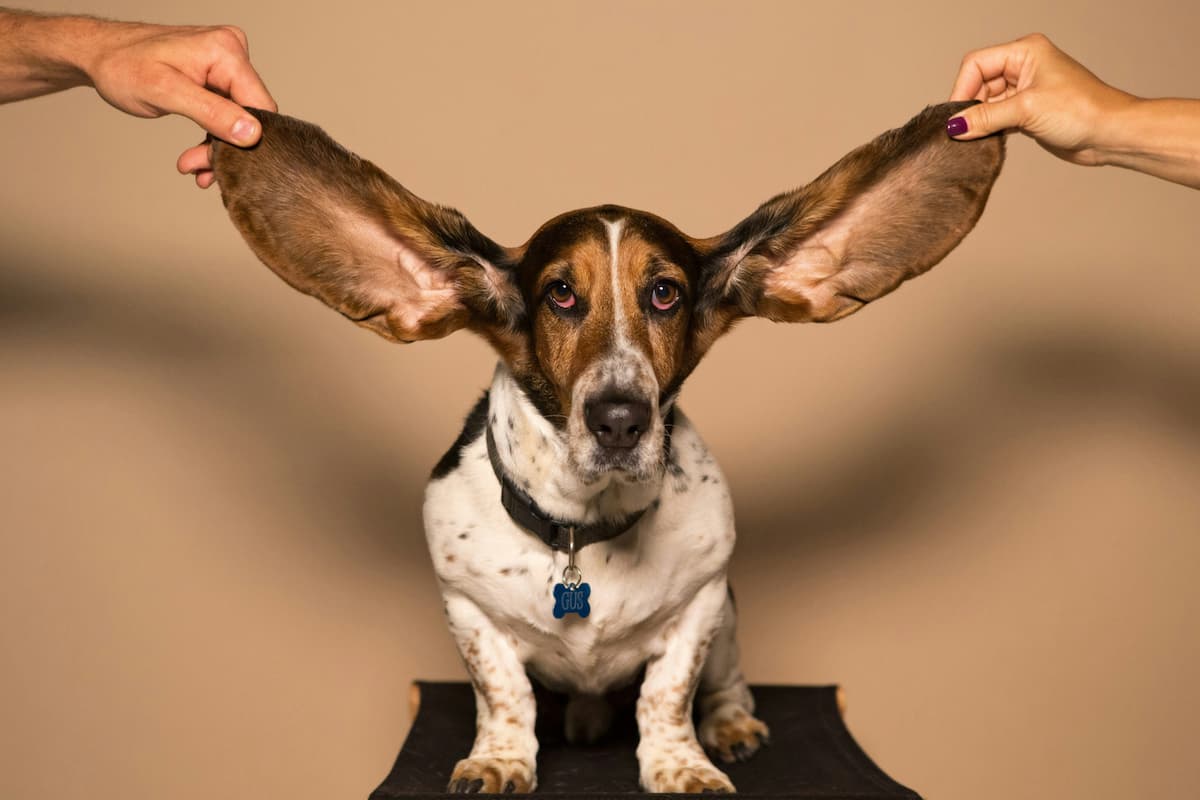Once upon a time, in our furry friend’s secret canine world, a fascinating tale unfolds: why do dogs pull their ears back?
Picture this: you’re playing fetch with your loyal companion in the park, when suddenly, their ears drop backward as if they’ve discovered a hidden treasure.
Curiosity piqued?
Read on to answer the question: Why do dogs pull their ears back?
Unveiling the Secrets Why Do Dogs Pull Their Ears Back?
Dogs are masters of non-verbal communication, and one intriguing aspect of their body language is the movement of their ears.
When you see a dog pulling their ears back, it can signify a variety of emotions and intentions.
So, why do dogs exhibit this behavior? Here are some of the hidden meanings behind this intriguing ear movement:
Feelings of fear or anxiety: One common reason why dogs pull their ears back is to show that they are feeling fearful or anxious.
When a dog is scared, they instinctively try to make themselves look smaller and less threatening.
By pulling their ears back, they are attempting to hide their vulnerability and avoid any potential confrontation.
It’s crucial to approach a fearful dog with caution and give them the space they need to feel safe.
Submission and appeasement: Dogs are social animals with a complex hierarchy, and they have specific ways of showing deference to higher-ranking individuals.
Pulling their ears back is one such submissive gesture that dogs display to communicate their non-threatening intentions.
It’s their way of saying, “I mean no harm, and I acknowledge your authority.”
This behavior is often observed when dogs are interacting with dominant or assertive individuals, be it other dogs or even their human owners.
Excitement or alertness: On the other hand, ear pulling can also be a sign of extreme alertness or excitement.
Think about when your dog spots a squirrel or a mailman approaching.
Their ears may instantly pull back as they focus intensely on the stimulus. It’s their way of honing in on the source of interest and preparing to react.
Keep an eye out for other signs, such as heightened attention or a rigid stance, which may indicate that your pup is simply on high alert.
Physical discomfort or pain: Sometimes, dogs pull their ears back as a response to physical discomfort or pain.
Ear infections, foreign objects, injuries, or other medical conditions can make their ears sensitive or painful, leading them to adopt this posture.
If you notice your dog persistently exhibiting this behavior or showing signs of discomfort, it’s important to consult with a veterinarian to rule out any potential health issues.
Ensuring your furry friend’s well-being should always be a priority.
Addressing Ear Pulling Behavior Effectively
If you notice your pup pulling their ears back frequently, it’s important to address this behavior to ensure their comfort. Here are a few tips that can help:
1. Create a safe and calm environment: Provide a quiet space where your dog can retreat to when they feel overwhelmed.
This designated area should be free from loud noises and provide a sense of security.
2. Gradual desensitization: If your dog becomes anxious or fearful in specific situations, such as car rides or grooming, introduce them to these scenarios gradually.
Start with short sessions and gradually increase the duration as they become more comfortable.
3. Positive reinforcement: Reward your dog’s calm and relaxed behavior.
Use treats, praise, or playtime to reinforce positive associations with situations that previously made them pull their ears back.
Remember, understanding why dogs pull their ears back can help us address their insecurities effectively.
By creating a nurturing and comforting environment and utilizing positive reinforcement, we can help our furry friends feel at ease and confident.
Consult Professionals for Ear-pulling, Veterinarians or Animal Behaviorists.
If you notice your dog frequently pulling their ears back in combination with other concerning behaviors, it might be time to consult a veterinarian or an animal behaviorist.
Here’s when seeking professional help is highly recommended:
Persistent Discomfort: If your furry companion consistently pulls their ears back, shakes their head vigorously, or scratches excessively, it could be a sign of an underlying ear infection.
These infections can cause discomfort and pain, leading to the instinctive behavior of ear-pulling.
A veterinarian will be able to diagnose and provide the necessary treatment to alleviate your dog’s discomfort.
Sudden Behavioral Changes: Suppose your dog’s ear-pulling is accompanied by sudden behavioral changes, such as aggression, fearfulness, or avoidance.
In that case, consulting an animal behaviorist can help determine if there are any underlying emotional or psychological issues at play.
They can provide guidance on how to address these behaviors and help your furry friend live a happier, more balanced life.
Consistent Ear Damage: Excessive or aggressive ear-pulling can lead to physical damage, such as injuries, infections, or bloodied ears.
If you notice any signs of injury or damage to your dog’s ears, seeking immediate veterinary care is crucial.
A veterinarian will be able to assess the extent of the damage and provide appropriate medical treatment to prevent further complications.
Remember, every dog is unique, and their behaviors may vary.
While occasional ear-pulling is usually harmless, it’s crucial to stay attuned to your dog’s overall well-being.
By understanding when it’s necessary to seek professional help, you can ensure your furry friend receives the care they need to live a happy, healthy life.
FAQ
Q: Why do dogs pull their ears back?
A: Ah, it’s a common dog behavior that can have different meanings depending on the context.
Often, when a dog pulls their ears back, it indicates that they are feeling anxious or scared.
It’s like their way of trying to make themselves appear smaller or less threatening. It’s their instinctual response to a perceived threat or uncomfortable situation.
Q: Are there any other reasons why dogs may pull their ears back?
A: Absolutely!
Dogs might also pull their ears back when they’re feeling submissive.
It’s a way for them to show respect to more dominant dogs or even to humans.
So, if you see a dog doing this while approaching another dog or a person, it usually means they’re acknowledging the other’s authority.
Q: Can it be a sign of pain?
A: Great question!
Yes, it’s possible that a dog pulling their ears back could be indicative of pain or discomfort.
Ear infections, injuries, or even something as simple as an earache can lead to this behavior.
So, if you notice persistent ear pulling accompanied by other signs like shaking the head, redness, or discharge, it’s crucial to consult a veterinarian for a proper diagnosis and treatment.
Q: Can dog breeds influence this behavior?
A: Absolutely!
Different breeds may have distinct behaviors or tendencies, including ear pulling.
For instance, dogs with large, floppy ears like Basset Hounds or Cocker Spaniels often have more noticeable instances of ear-pulling due to their ear anatomy.
It’s important to consider these breed-specific characteristics when trying to interpret a dog’s behavior.
Q: Is there anything we can do to help a dog that pulls its ears back?
A: Of course!
If your dog is pulling their ears back out of anxiety or fear, creating a calm and safe environment is crucial.
Making sure they have a cozy spot to retreat to, using positive reinforcement techniques to build their confidence, and providing plenty of mental and physical stimulation can all help ease their anxiety.
However, if the ear pulling is due to pain or discomfort, seeking veterinary care is vital for proper treatment and relief.
Q: Can we train a dog not to pull their ears back?
A: Dogs respond well to positive reinforcement training, so it might be possible to help them adopt alternative responses to certain situations that trigger the ear-pulling behavior.
However, it’s worth remembering that it’s a part of their natural instincts, so completely eliminating it may not be realistic or humane.
Instead, focusing on helping them feel more secure and comfortable in various situations can be a better approach.
Q: Well, this has been quite an eye-opening discussion!
Anything else we should keep in mind about dogs and their ear-pulling habit?
A: Indeed!
Remember, every dog is unique, and their behavior may vary.
If you’re ever unsure about why your dog is pulling their ears back or if you notice any sudden changes in their behavior, it’s always wise to consult with a professional, such as a veterinarian or a certified dog behaviorist.
They can provide you with tailored guidance and ensure the well-being of your beloved furry friend.
Key Takeaways
First and foremost, it’s crucial to remember that dogs communicate through their body language, and their ears play a significant role in this canine conversation.
While it might seem like a simple gesture, pulling their ears back can convey a multitude of emotions and messages.
For some pups, pulling their ears back is a sign of submission.
Just like us humans might lower our heads or avoid eye contact in certain situations, dogs opt for this ear-pulling move to show respect and deference to their pack leaders or other dogs.
On the other paw, it’s not unusual to see our four-legged companions tuck their ears back when they’re feeling anxious or fearful.
This tucked ear look helps them protect their delicate hearing organs while highlighting their vulnerability.
So, next time you spot a canine with ears slicked back, remember to approach with care, as they might need a bit of comfort.
Similarly, when dogs are in a playful mood, they might wag their tails, wag their ears (yes, it’s a thing!), and pull those floppy ears back in a gesture of excitement and joy.
It’s their way of saying, “Hey, let’s have some fun!” So, why not join the party and give them a good belly rub?
Lastly, it’s worth mentioning that some dogs pull their ears back simply because they were born that way.
Certain breeds—like Greyhounds, Whippets, and Chihuahuas—have naturally large or pointy ears that tend to lay back against their heads.
While this might give them a sleek and stylish look, it doesn’t necessarily reveal any emotional state.
Remember, every dog is unique, and their ear-pulling antics can have various meanings depending on the situation and their individual personalities.
As pet parents and dog lovers, it’s essential to pay attention to their overall body language and other signals they’re sending us to better understand their feelings and needs.
So, next time you catch your furry companion pulling their ears back, take a pause and consider the context.
Are they feeling submissive, anxious, or maybe just excited?
By decoding their silent language, we can deepen our bond with our furry pals and be the best companions they could ever ask for.














